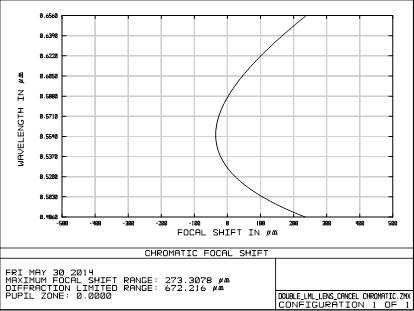An adaptive achromatic doublet design by double variable focus lenses
Summary
In optics, chromatic aberration is one of the typical aberrations which is caused by the different refractive index for different wavelength of light. The refractive index decreases with the increasing of wavelength. This physic phenomenon results in that the lens cannot focus all colors to the same convergence point. In consequence, the image will not be sharp and the system's resolution will be decreased.
To minimize the chromatic aberration, the most common solution is to design an achromatic doublet, which composes a low-relative-dispersion element and a high-relative-dispersion element. The typical candidate is a combination of a positive crown glass lens and a negative flint glass lens. Basically, the crown lens with low-relative-dispersion is in front and showing the same sign power with the doublet, and the flint lens with a high-relative-dispersion is in the back and showing a weak negative sign power against the doublet. With the help of this technique, different wavelengths of light, like red and blue lights, could be brought back to a common focus.
We reported an adaptive achromatic doublet which was composed by double variables focus lenses. They had large optical apertures, because they were based on the liquid-membrane-liquid structure. The two lenses employed different liquids so that they could perform low and high dispersion prosperities. Comparing with singlet variable focus lens, the chromatic aberration of the new doublet was suppressed and its chromatic focal shift range was improved from 2.5% of focal length to 0.06%. The greatest merit of the adaptive achromatic doublet system is that when two variable focus lenses control their focal lengths under an engagement strategy, the doublet could perform a dynamitic focal length and the chromatic aberration could be corrected at the same time.

|
| Figure 1. (Left)Chromatic aberration on a singlet. (Right)A typical solution to correct chromatic aberration by employing a crown lens and a flint lens. |

|
| Figure 2. A sketch of the achromatic variable focus doublet. It was composed by two variable focus lenses, who were filled with different type of liquids so as to perform different dispersions. |
|---|
| The following simulation was run with a target of effective focal length of 500 mm. A comparison between adaptive singlet and doublet was conducted. Click here for other plots . |
|---|

|

|
| Figure 3. (Left) Chromatic focal shift of Adaptive Singlet. | (Right) Chromatic focal shift of Doublet Singlet. |
|---|
References
- Lihui Wang, Hiromasa Oku, Masatoshi Ishikawa, Adaptive achromatic doublet design by double variable-focus lenses, SPIE Optics + Photonics 2014 (San Diego, California, USA, 2014.08.17-21) / Proc. of SPIE, Vol. 9193, 91930O-1 (Oral Session) [DOI:10.1117/12.2061203]
- Lihui Wang, Hiromasa Oku, Masatoshi Ishikawa, An improved low-optical-power variable focus lens with a large aperture, Optics Express, Vol.22, Issue 16, pp. 19448-19456 (2014)[PDF(2.2M)][DOI:10.1364/OE.22.019448]
- Also selected for the Virtual Journal for Biomedical Optics, Vol.9, Issue 10 (2014)
- Lihui Wang, Hiromasa Oku, Masatoshi Ishikawa, Variable-focus lens with 30 mm optical aperture based on liquid--membrane--liquid structure, Applied Physics Letters, Vol.102, 131111 (2013)[PDF(1.1M)][DOI:10.1063/1.4800603]*AIP
*AIP © 2013 American Institute of Physics. This article may be downloaded for personal use only. Any other use requires prior permission of the author and the American Institute of Physics. The article appeared in L. Wang et al.,Appl. Phys. Lett. 102, 131111 (2013) and may be found at http://link.aip.org/link/?APL/102/131111.



